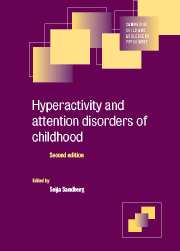Book contents
- Frontmatter
- Contents
- List of contributors
- Preface
- 1 Historical Development
- 2 Epidemiological aspects: what have we learned over the last decade?
- 3 Cross–cultural/ ethnic aspects of childhood hyperactivity
- 4 4 Sex differences and their significance
- 5 Classification issues
- 6 The role of attention
- 7 Cognitive aspects and learning
- 8 Developmental perspectives
- 9 Behavioural and molecular genetic studies
- 10 Biological underpinnings of ADHD
- 11 Psychosocial contributions
- 12 Institutional care as a risk factor for inattention/overactivity
- 13 Treatments: The case of the MTA study
- 14 Attention feficit hyperactivity disorder in adults
- Index
11 - Psychosocial contributions
Published online by Cambridge University Press: 28 August 2009
- Frontmatter
- Contents
- List of contributors
- Preface
- 1 Historical Development
- 2 Epidemiological aspects: what have we learned over the last decade?
- 3 Cross–cultural/ ethnic aspects of childhood hyperactivity
- 4 4 Sex differences and their significance
- 5 Classification issues
- 6 The role of attention
- 7 Cognitive aspects and learning
- 8 Developmental perspectives
- 9 Behavioural and molecular genetic studies
- 10 Biological underpinnings of ADHD
- 11 Psychosocial contributions
- 12 Institutional care as a risk factor for inattention/overactivity
- 13 Treatments: The case of the MTA study
- 14 Attention feficit hyperactivity disorder in adults
- Index
Summary
Environmental and psychosocial factors such as socioeconomic deprivation, family discord and dysfunctional parent–child relationships are well acknowledged as risk factors for disruptive behaviour disorders in childhood. Whether the same adversities also contribute to the causal processes of particular subtypes of childhood behaviour disorder, namely hyperactivity and attention deficit disorders, remains less clear. There are two principal reasons for this. First, compared with biological and especially genetically mediated influences, psychosocial factors have tended to be viewed as peripheral to the aetiology of hyperactivity and attention disorders (Schachar, 1991; Cantwell, 1996; Tannock, 1998). Second, a majority of the evidence available so far concerns disruptive behaviour in general, rather than being specific to hyperactivity and attention disorders. Given the high degree of symptom overlap and diagnostic comorbidity between the two groups of disorders it is often unclear whether the reported associations apply to hyperactivity, conduct disorder, or both. Therefore, the presumed psychosocial correlates of hyperactivity may in fact be those of conduct disorder, or even nonspecific correlates of psychiatric disturbance in general. There is one possible exception regarding the specificity of psychosocial risk for hyperactivity: this concerns the role that may be played by severely disrupted early attachments, occurring in the contexts of institutional rearing and maternal depression, for example, in contributing to the cause of attention deficit and hyperactivity disorders (Haddad and Garralda, 1992; Sroufe 1997; Sroufe et al., 1999; Chapters 8 and 12).
- Type
- Chapter
- Information
- Hyperactivity and Attention Disorders of Childhood , pp. 367 - 416Publisher: Cambridge University PressPrint publication year: 2002
- 11
- Cited by



